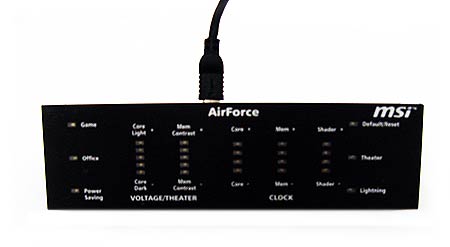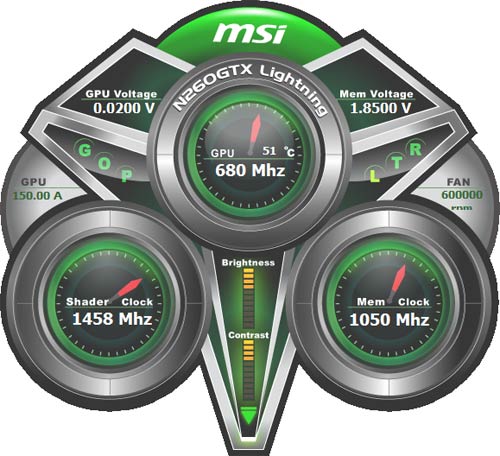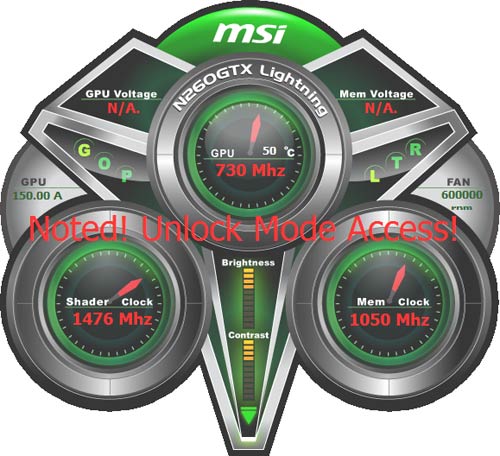GeForce 9600 GT/GTS 250/GTX 260 Non-Reference Roundup
MSI N260GTX Lightning Black Edition, Cont’d.
The N260GTX Lightning has unique outputs: a single DVI, a single VGA, and a single HDMI. While this sounds like par for the course, it’s important to note the MSI’s HDMI output includes an audio codec, so a separate HDMI audio cable isn’t required, as it is for most other GeForce cards with HDMI outputs.
What are the base clocks on the MSI N260GTX Lightning? Unfortunately, there’s no easy answer. Most of the documentation we saw claimed 680 MHz core/1,458 MHz shader/1,050 MHz memory. But when the card is installed, the default clock speeds are 655 MHz core/1,404 MHz shader/1,010 MHz memory.
On the bright side, we were able to quickly reach the advertised clock speeds by adjusting the AirForce panel to its maximum values, so we tested the card at the MSI-advertised speeds of 680 MHz core/1,458 MHz shader/1,050 MHz memory.
Overclocking
Any overclocking for the N260GTX Black Edition is done with the AirForce's touch-sensitive panel. It is designed to fit perfectly in an external 5 1/4" optical drive bay, or alternatively it can be placed on your desk. Either way, it's attached to the PC via a USB cable.

A few words about the AirForce panel. There are no physical buttons per se, only areas of the panel that are touch-sensitive. This is pretty nifty in concept, but it made us realize that there is, in fact, value to tactile, physical buttons, as sometimes it was difficult to know if we were touching the right spot.
For detailed feedback, there is an on-screen display that will activate when the Lightning Area button is pressed, displaying voltages, clock speeds, and temperatures. This screen disappears when the Lightning button is pressed again. In theory, it will pop up seamlessly in games, but we found it wouldn't work with some titles. Realistically, though, we wouldn't expect many folks to want to overclock from within their favorite game.
Get Tom's Hardware's best news and in-depth reviews, straight to your inbox.

In any case, an overclocker is only as good as his or her tools, and overclocking the MSI N260GTX Lightning Black Edition is only as effective as the AirForce Panel. Without any other bundled overlocking software, this is the only interface that the user has to make necessary modifications to the MSI card, and this is where the N260GTX fundamentally differentiates itself from the Asus ENGTX260 Matrix. So, how did it stack up?

While the Asus ENGTX260 Matrix offers the infinitely tweakable iTracker software, MSI’s AirForce panel approaches the overclocking task with a simplified, but perhaps less powerful interface. The panel allows the user to increase or decrease both voltages and clock speeds with simple "+ or –" steps. But once the advertised 680 MHz core/1,458 MHz shader/1,050 MHz memory speed is reached, MSI's AirForce panel requires a different interface paradigm to take the overclocking to the next level.
By holding down the Lightning button for three seconds, the user is given access to the Unlock Mode, which is the only way to take the card past 680 MHz when using the AirForce panel. Once you have entered Unlock Mode, you are no longer allowed to make voltage or memory clock speed changes. All you can do is increase or decrease the core clock speed, which in turn will increase or decrease the shader clock speed in a linked fashion.

The most frustrating aspect is that this overclocking method removes control of the minutia when the serious overclocker needs it the most. Having said that, it's a more straightforward process for the casual overclocker.
We managed to achieve a stable core clock speed of 730 MHz, a shader clock of 1,476 MHz, and a memory clock speed of 1,050 MHz.
There’s certainly nothing wrong with a 730 MHz core clock speed on a GeForce GTX 260. The MSI N260GTX Lightning is an impressive card, but coming from the perspective of a hardcore tweaker, we can’t help but wish that the software side of things would have allowed for more precise control.
Current page: MSI N260GTX Lightning Black Edition, Cont’d.
Prev Page MSI N260GTX Lightning Black Edition Next Page Test System And Benchmarks-
Mottamort I was rather disappointed with this article. Not the article itself but with the slightly misleading Title/Intro. When clicking the article I thought I was going to find a massive battle between these vendors on different tiers, instead you show us different instances of 2 slightly different cards of the same type from one vendor....if that makes senseReply
I mean you have Gigabyte vs Gigabyte in the 9600gt section, Asus vs Asus in the 250 section and so on.
:-/ -
dragonsprayer Great articleReply
i wish it had more cards, i think you need 4 parts, try some back cards like the 4870x2 darkknight? good stuff as always!
thx! -
crisisavatar wow how is the gts 250 performing so close to the gtx 260 wasn't the gtx 260 20% faster ?Reply -
enterco It's not clear to me why are you comparing '3dmark score' when you should post 'GPU score'.... It's a graphics card comparision, not platform comparision.Reply -
randomizer entercoIt's not clear to me why are you comparing '3dmark score' when you should post 'GPU score'.... It's a graphics card comparision, not platform comparision.Nothing but the cards is changed so you're not comparing platforms.Reply -
acasel We cannot see clearly the bang for the buck card there if we ain't seeing some ati cards like the 4770 and others..Reply
The drop down menu sure is fast... :-) -
enterco randomizerNothing but the cards is changed so you're not comparing platforms.Sure. A reason more to show GPU score. 3dmark score is too much influenced by CPU's power, and it's no longer relevant, the way it used to be once...Reply
By using a Quad Core and a low-performing GPU you can achive same 3dmark score as using a dual core combined with a considerably stronger GPU, 3dmark Vantage gives too much credit to CPU. But the overall FPS in games it's often higher in the second case: dual core + better GPU. -
marraco Recent review showed the 260 being neck to neck with the 4870; both in price and performance, those cards are in the same point.Reply
Since my 8800GT should be between the 9600 and the 250, I guess that the best upgrade path is to buy a second 8800GT, reaching probably 260/4870 performance.
I searched the web for 8800GT SLI benckmark running in i7 920, but got no one single review...
I think that tomshardware should review non up-to-date cards as the 8800 and the ATI equivalents, in crossfilre/SLI, since for many users, it should make sense to buy a second card that to upgrade to a 260/4870.
older reviews on those cards does not accounted for the scalability on I7 x58 platform, and probably ATI and Nvidia dedicated more time tweaking drivers for newer cards, so maybe the 8800GT does not perform well today (the SLI on core 2/Quad did not worked very well in the past)